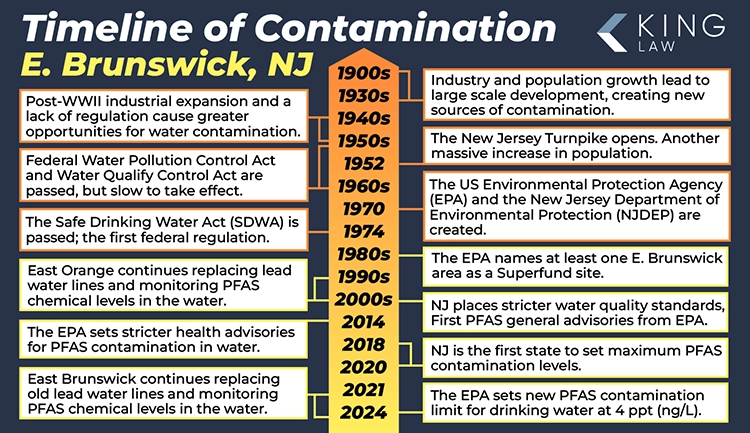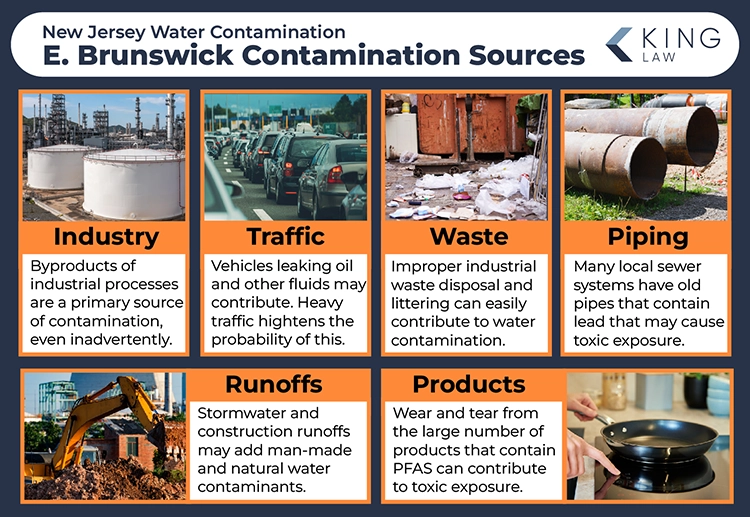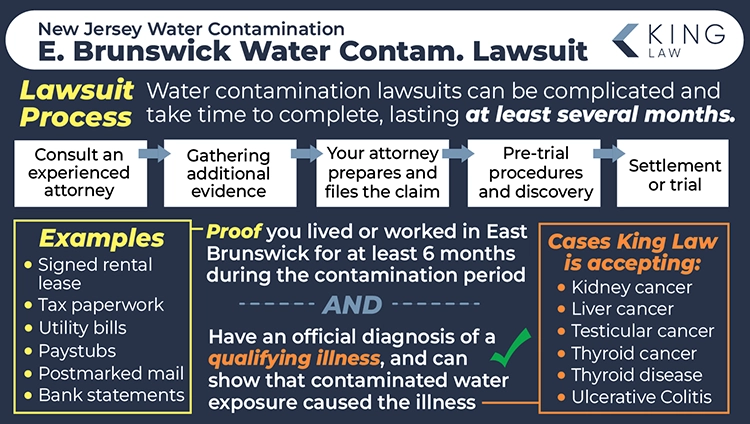
East Brunswick, NJ faces many water contamination concerns that have affected the state for years. Recently, concerns have centered on the presence of per- and polyfluoroalkyl substances (PFAS) in local water.
Known as “forever chemicals,” PFAS can exist in the environment and the human body for long periods. Long-term exposure to them may raise your risk of multiple health issues, including kidney, liver, and testicular cancers, thyroid disease, ulcerative colitis, and more. Many East Brunswick residents harmed by water contamination are filing lawsuits against manufacturers. King Law is helping them seek appropriate compensation for the damage done.
East Brunswick Water Contamination Lawsuit Overview
Originally a rural community, East Brunswick has been New Jersey’s population center since at least 2000. The area’s population began to boom in the 1930s when access to better roads brought many commuters who preferred the suburbs to New York City. Population growth surged further after the construction of the New Jersey Turnpike in the 1950s. Besides remaining a popular bedroom community, East Brunswick today boasts a thriving business sector of its own.
However, population growth brought more traffic, people, waste, and more opportunities for pollution. Since at least the 1970s, East Brunswick residents have voiced concerns about the dangers posed by environmental contamination. For example, water contamination has long been a worry. Potentially harmful substances, like PFAS and lead, may exist in the area’s water. In turn, these contaminants may pose serious health risks to locals. King Law is assisting East Brunswick residents affected by PFAS seek compensation.
East Brunswick Water Contamination Lawsuit Updates
- 1900s – 1930s: Large-scale development of the New York suburbs, including East Brunswick, begins. Local industry and population begin to grow. This growth also brings new sources of water contamination to the area.
- 1940s – 1950s: Expansion of industry and infrastructure — particularly following World War II — create further opportunities for water contamination. Few regulations exist to ensure safe drinking water.
- 1952: The New Jersey Turnpike opens in East Brunswick, leading to explosive population and commercial growth.
- 1950s – 1960s: The federal Water Pollution Control Act and Water Quality Act are passed. However, many regulations are slow to take effect.
- 1970: The U.S. Environmental Protection Agency (EPA) and the New Jersey Department of Environmental Protection (NJDEP) are created.
- 1974: The Safe Drinking Water Act (SDWA) sets the first federal drinking water standards.
- 1980s: Increasing scrutiny arises regarding contaminants in New Jersey water. The EPA names at least one area in East Brunswick as a Superfund site due to serious environmental pollution.
- 1990s-2000s: Studies begin to reveal potential threats from PFAS contaminants in America’s water.
- 2000s: New Jersey implements stricter water quality standards. The EPA releases its first general advisories about the presence of PFAS in the nation’s water.
- 2010s: Concerns about chemical contamination in East Brunswick’s water continue. PFAS chemicals and lead contamination from outdated piping remain among the top concerns.
- 2014: The EPA begins stricter health advisories for PFAS contamination in drinking water.
- 2018 – 2020: New Jersey is the first state to set a maximum contaminant level (MCL) standard for any PFAS chemical.
- 2021 – Present: East Brunswick continues to replace outdated lead water lines. The city also continues to monitor and control the level of PFAS chemicals in water.

About East Brunswick, NJ Water Contamination:
History of Water Contamination in East Brunswick, New Jersey
Sources of Water Contamination in East Brunswick
East Brunswick, New Jersey Water Contamination Map
East Brunswick, New Jersey Drinking Water Contaminants
Current Water Quality in East Brunswick, New Jersey
Health Risks Linked to Drinking Tap Water in East Brunswick
Eligibility Criteria for the East Brunswick Water Contamination Lawsuit
East Brunswick Water Contamination Settlement and Payout Amounts
How to File a East Brunswick, New Jersey Water Contamination Lawsuit
Statute of Limitations for East Brunswick Water Contamination Claims
History of Water Contamination in East Brunswick
Like many cities surrounding New York, East Brunswick experienced significant growth in the latter half of the 20th century. As new roadways came to the area, moving to the suburbs became one of the ideals of the American dream. This expansion brought new populations, major construction, and expanding industry to small towns.
Still, with this growth came new sources of water contamination. East Brunswick was not immune to the threat. For example:
- In an era when industrial health and safety standards were far less rigorous, it was often easy for contaminants from industry to permeate East Brunswick’s water.
- Contaminated runoff from the area’s massive construction projects could seep into the water.
- Significant traffic along the Jersey Turnpike was a noted source of pollution. Spilled fluids from increased traffic could seep into the ground and the local water.
- With more people came an increased need for more sewer and water services. However, many original sewage and pipe systems were made of lead. Only in recent decades has the public become more aware of the health risks lead poses.
- Littering and improper waste disposal often made it easy for contaminants to spill into the environment.
Finally, simple human activities may also contaminate the local water. For example, it’s often easier than you think for chemicals from various detergents to infiltrate the water supply. Moreover, PFAS chemicals may also exist in household items, such as food packaging or nonstick cooking materials. When these chemicals seep into the water, they can remain there for an extremely long time. In turn, they may increase consumers’ risks of various illnesses.
Sources of Water Contamination in East Brunswick
Water contamination in East Brunswick might come from a variety of sources. For example:
- Industry and business in East Brunswick are among the primary contributors to the area’s water contamination. Chemicals used in industry can often contaminate the water, even inadvertently.
- Heavy traffic in the area might leak oil and other fluids that could seep into the water supplies and contaminate the area.
- Runoff from stormwater or construction may add man-made and natural contaminants to the water.
- Improper waste disposal and littering could easily add chemicals to the water.
- The profusion of chemicals and PFAS in everyday household items are big contributors to local water contamination.
- Original lead piping in many local sewer and water systems may cause toxic exposure.
The profusion of water contamination may increase the public’s risk of various health issues. Despite efforts by local, state, and federal authorities to mitigate contamination risks and provide safe drinking water, concerns remain.

East Brunswick Water Contamination Map
PFAS chemicals and other water contaminants put East Brunswick, New Jersey’s population at risk. This water contamination map shows various sites of pollution affecting the area.
Contaminants Found in East Brunswick Drinking Water
Multiple substances have appeared in East Brunswick’s water at various times. Some of these contaminants have exceeded the recommended levels set by the Environmental Working Group (EWG).
Arsenic
Arsenic, a well-known carcinogen and toxin, can enter the water supply as a naturally occurring mineral. However, it can also enter water through human activities like industry and agriculture. Prolonged exposure to arsenic not only poses a fatal risk but also increases the likelihood of developing various cancers, diabetes, skin conditions, and cardiovascular disease. Arsenic levels in East Brunswick have been detected at over 257 times the EWG’s recommended safety limit.
Chloroform
Chlorine is frequently used to disinfect water, but when it reacts with natural materials and organic matter, it can produce chloroform. In turn, this chloroform can remain in the water. Exposure to chloroform can elevate someone’s risk of cancer, kidney and liver damage, as well as nervous system harm. It may also lead to birth defects and pregnancy complications. In East Brunswick, chloroform levels in the water have been found to be 88 times higher than the health guidelines recommended by the EWG.
Lead
Exposure to lead is a serious problem and can cause substantial health risks. Adults may be at a higher risk of kidney problems, cardiovascular issues, and various cancers. In pregnant women, lead exposure may lead to low birth weights and premature births. In children, it may cause behavioral problems, lower IQs, anemia, and more. Like many cities, East Brunswick, NJ once relied heavily on lead piping in the plumbing system. However, the discovery of lead’s adverse effects created a need for large-scale pipe replacement. East Brunswick continues this effort to this day in various shapes and forms.
Per- and poly-fluoroalkyl substances (PFAS)
PFAS chemicals have been widely used for decades in products like nonstick cookware, food packaging, and firefighting foam. However, they can persist in the environment and the human body for extremely long periods. Even at trace levels, PFAS chemicals may pose significant health risks to consumers. Exposure to PFAS has been linked to various cancers, thyroid disorders, ulcerative colitis, weakened immune function, and other health issues. According to East Brunswick’s 2024 water quality report, at least three types of PFAS chemicals — PFOS, PFOA, and PFPeA — appeared in local water during the last year. They have been detected at levels up to 4.3, 7.7, and 3.0 parts per trillion (ppt) respectively.
Other Contaminants
Various other contaminants have appeared in East Brunswick’s drinking water. Each presents potential health risks:
- Bromodichloromethane: Bladder cancer and other cancers, fetal development problems
- Chromium: Stomach cancer, intestinal cancer, weakened skeletal systems
- Dibromoacetic acid: Cancer, problems with pregnancy
- Dibromochloromethane: Cancer, problems with pregnancy
- Dichloroacetic acid: Cancer, problems with pregnancy
- Haloacetic acids (HAA5 & HAA9): Cancer, harm to pregnancy
- Nitrate: Colorectal cancer, ovarian cancer, thyroid cancer, kidney cancer, bladder cancer, hypothyroidism
- Trichloroacetic acid: Bladder cancer, skin cancer, harm to fetal development
- Uranium: Kidney damage, respiratory problems, birth defects, reproductive problems, cancer
Current Water Quality in East Brunswick
East Brunswick’s water comes from the Middlesex Water Company (MWC). The City of East Brunswick and MWC must ensure their water meets applicable state and federal standards. Both parties must regularly test and publicly report on the levels of PFAS and other chemicals in their water.
On the one hand, East Brunswick’s water is compliant with safe drinking water standards. On the other hand, however, in Q2 2023, testing by the MWC revealed a level of PFOA that exceeded recommended guidelines. However, a new water treatment plant has recently helped the city work to come into compliance with newer PFAS safe water standards.
Regardless of the level of contaminants in water, however, it’s important to remember that just because something is legal does not mean it is safe. Exposure to even trace levels of contaminants in the local water may raise consumers’ risks of various health issues.
Water Treatment Efforts in East Brunswick
The City of East Brunswick and the Middlesex Water Company must ensure their water meets safe drinking water standards. The authorities regularly test local water to monitor contaminant levels. Chlorine is the primary treatment used to disinfect the water. The authorities also continue to adopt new technologies to help combat water contamination. In 2022, Middlesex Water Company opened a brand-new water treatment facility to begin treating water for the presence of PFAS substances.
Health Risks Linked to Tap Water in East Brunswick
Even after treatment, PFAS and other contaminants may remain in East Brunswick, New Jersey’s water. Some of the potential health risks posed by these contaminants include:
- Kidney problems
- High cholesterol
- Thyroid disease
- Weakened immune systems
- Endocrine and hormonal disorders
- Kidney cancer
- Testicular cancer
- Prostate cancer
- Skin cancer
- Lung cancer
- Ovarian cancer
- Liver disease
- Pregnancy-related high blood pressure
- Low birth weights
- Birth defects
- Neurological problems
- Cardiovascular disease
Heightened health risks from long-term exposure to contaminated water may affect anyone. In particular, vulnerable groups may face higher risks of adverse health effects. These groups include the elderly, children, pregnant women, and individuals with pre-existing conditions. Regular medical checkups and screenings can help detect and treat conditions linked to PFAS exposure. Still, even if you have insurance, your medical costs may be substantial. Pursuing a PFAS lawsuit might allow you to recover compensation.
Eligibility Criteria for the East Brunswick Water Contamination Lawsuit
King Law may be able to help those affected by water contamination in East Brunswick, NJ. To file a water contamination case, you generally must meet specific criteria:
Specific Diagnoses
King Law is evaluating potential water contamination cases involving a diagnosis of:
- Kidney cancer
- Liver cancer
- Testicular cancer
- Thyroid cancer
- Thyroid disease
- Ulcerative colitis
Duration of Exposure
You generally must have lived or worked in East Brunswick for at least six months during the period of water contamination. You will likely need to provide proof of residence or employment as evidence.
Required Documentation
Building a strong legal claim is essential for your water contamination case. The experienced attorneys at King Law can assist you in collecting crucial evidence — such as medical records, photographs, and proof of residence — to strengthen your claim.

East Brunswick Water Contamination Settlement and Payout Amounts
Your East Brunswick water contamination lawsuit could lead to a financial settlement. Settlements eliminate the need for a trial. Rather, they are an agreement between you and the party you sued for causing water contamination. Per the settlement, the other party agrees to pay for the harm you claim in your lawsuit.
The amount of money you may receive for your water contamination case may vary. However, settlements often range from $30,000 to $300,000, with many cases settling for over $100,000. On average, settlements are about $250,000.
Several factors may impact your final settlement amount, such as:
- The extent of your exposure to contaminants. Longer exposure may lead to higher settlements.
- The severity of your health issues. For example, if you’ve been diagnosed with cancer, your settlement might be different from someone with another condition.
- Your age. Younger individuals who suffer harm may receive larger settlements.
- The length of your illness. If your illness is prolonged or affects your quality of life or earning potential, you might receive more.
If your case goes to trial instead of settling, there’s a chance you could receive a higher award. However, a judge or jury will make the final decision, which means there’s also a risk of receiving nothing. King Law’s attorneys are experts in water contamination cases and can advise you on the best course of action for your case.
How to File an East Brunswick Water Contamination Lawsuit
Water contamination lawsuits typically take at least several months to resolve. The process will also usually involve multiple steps. These include:
- Initial Consultation: An experienced attorney will review your case and help you decide how to proceed.
- Evidence Gathering: You and your attorney will collect necessary evidence, such as medical records, proof of residence, photos, and environmental studies.
- Legal Filing: Your attorney files the required documents with the court. They will detail your case against those alleged to be responsible for water contamination.
- Pre-Trial Procedures: You’ll have a chance to exchange evidence and information with the other parties involved in your case. Depositions, interrogations, and other forms of questioning may also occur.
- Settlement Negotiations: Your attorney will negotiate with the defendant(s) for a fair settlement. If you reach a settlement, the case will not go to trial.
- Trial: If no settlement occurs, your case will proceed to trial. Your attorney will present your case to a jury or judge, who will then deliver a verdict. A verdict does not guarantee compensation.
King Law’s attorneys are well-versed in environmental law, personal injury law, and the New Jersey legal system. We can guide you through each step of your water contamination lawsuit to ensure you meet all legal requirements.
Evidence to Support Your Claim:
During your lawsuit, you’ll need evidence that shows East Brunswick’s drinking water harmed you. Some of the appropriate evidence may include:
- Medical Documentation: Records detailing your condition(s), diagnosis dates, and treatments.
- Proof of Residence/Employment: Documents showing you lived or worked in East Brunswick for at least six months during the contamination period. Utility bills, lease agreements, or employment records may suffice.
- Environmental Studies: Information on the levels and types of contaminants in East Brunswick’s water.
- Expert Testimony: Statements from medical professionals linking your health issues to the contaminated water.
- Personal Statements: Your account of how the water contamination has affected your health.
- Photographic Evidence: Photos showing the impact of the contamination on your health. Images of the sources of water contamination may also help.
- Receipts and Bills: Medical bills and other receipts demonstrating the financial impact of medical issues caused by contaminated water.
Strong evidence may increase your chances of receiving a fair settlement. King Law’s professionals are available to assist you throughout the evidence-gathering process.
Statute of Limitations for East Brunswick Water Contamination Claims
In East Brunswick, NJ, PFAS lawsuits are governed by a statute of limitations. Under the statute, you must file your lawsuit within a certain time frame. If you don’t, you won’t be able to take legal action later. The statute of limitations is typically two years from the date you were diagnosed with a contamination-related illness. An attorney may be able to better help you determine your specific eligibility to file a lawsuit. Contact King Law to get started with your case.
East Brunswick, NJ Water Contamination Lawyers
You deserve an experienced attorney by your side during your East Brunswick water contamination lawsuit. King Law’s attorneys understand the complexities of New Jersey’s legal code, environmental statutes, personal injury law, and courts. Our comprehensive legal services can take you from consultation to settlement or trial, and we’ll be by your side throughout. Don’t hesitate to contact us to discuss your needs today.
Frequently Asked Questions (FAQs)
Learn more about the East Brunswick, NJ water contamination with these frequently asked questions.

